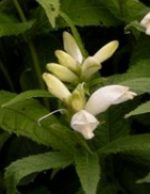 Also called snakehead and balmony, this herbaceous perennial is a member of the plantain family, Plantaginaceae, that also includes foxglove, snapdragon, and angelonia. It is native to North America from Newfoundland to north Georgia, and west to Minnesota where they grow in wet areas such as riparian forests, flood plains, and swamps. Growing 2′-3′ tall from a rhizomatous rootstock, the plants form stiff clumps of erect stems bearing sessile, lanceolate , toothed leaves 6-8″ long. One inch long flowers appear in terminal compact spikes 6-8″ long in summer for three to four weeks. The flowers are white sometimes tinged with rose, two lipped, and supposedly resemble turtle’s heads. They attract bumblebees, ruby-throated hummingbirds and other pollinators, and the plant is a host for the Baltimore checkerspot butterfly. Since turtlehead grows best in moist soils in part shade they are a good choice for shade, bog, and woodland gardens as well as on the edges of ponds and streams. The genus name, Chelone, is the Greek word meaning tortoise. The specific name, glabra, is the Latin word meaning hairless.
Also called snakehead and balmony, this herbaceous perennial is a member of the plantain family, Plantaginaceae, that also includes foxglove, snapdragon, and angelonia. It is native to North America from Newfoundland to north Georgia, and west to Minnesota where they grow in wet areas such as riparian forests, flood plains, and swamps. Growing 2′-3′ tall from a rhizomatous rootstock, the plants form stiff clumps of erect stems bearing sessile, lanceolate , toothed leaves 6-8″ long. One inch long flowers appear in terminal compact spikes 6-8″ long in summer for three to four weeks. The flowers are white sometimes tinged with rose, two lipped, and supposedly resemble turtle’s heads. They attract bumblebees, ruby-throated hummingbirds and other pollinators, and the plant is a host for the Baltimore checkerspot butterfly. Since turtlehead grows best in moist soils in part shade they are a good choice for shade, bog, and woodland gardens as well as on the edges of ponds and streams. The genus name, Chelone, is the Greek word meaning tortoise. The specific name, glabra, is the Latin word meaning hairless.
Type: Herbaceous perennial
Bloom: Clusters of white, two-lipped, 1″ long flowers in terminal compact spikes 6-8″ long in summer for three to four weeks.
Size: 2-3′ H x 2″ H
Light:Partial shade to sun
Soil:Fertile, consistently moist to wet
Hardiness: Zones 3-8
Care: Pinch in spring to reduce ultimate size; may need staking if grown in too much shade.
Pests and Diseases: None of significance but susceptible to mildew in dry conditions
Propagation: Seed, division in early spring or fall, cuttings in spring and summer
Companion Plants: Rodgersia, ligularia, great blue lobelia, cardinal flower (Lobelia cardinalis), Joe-Pye weed, Japanese anemone,